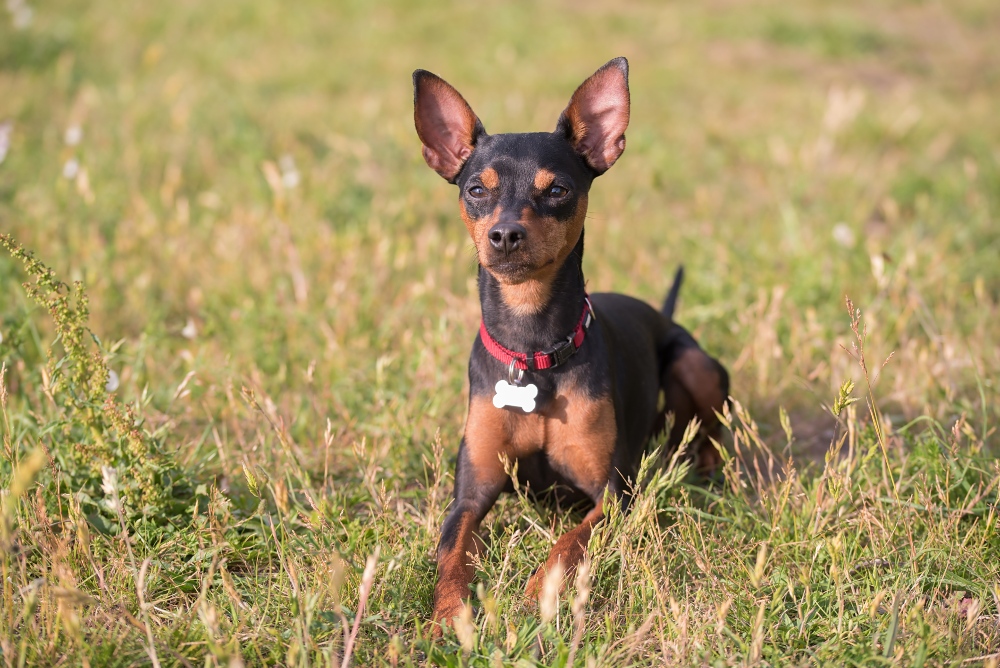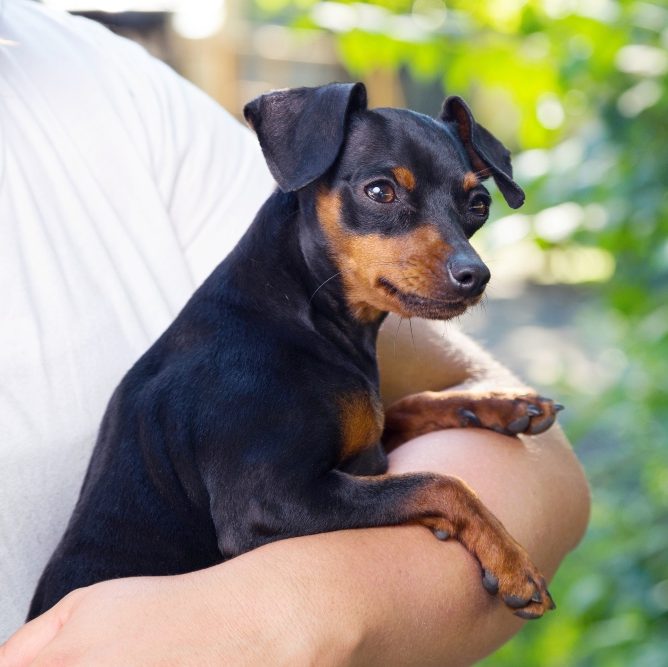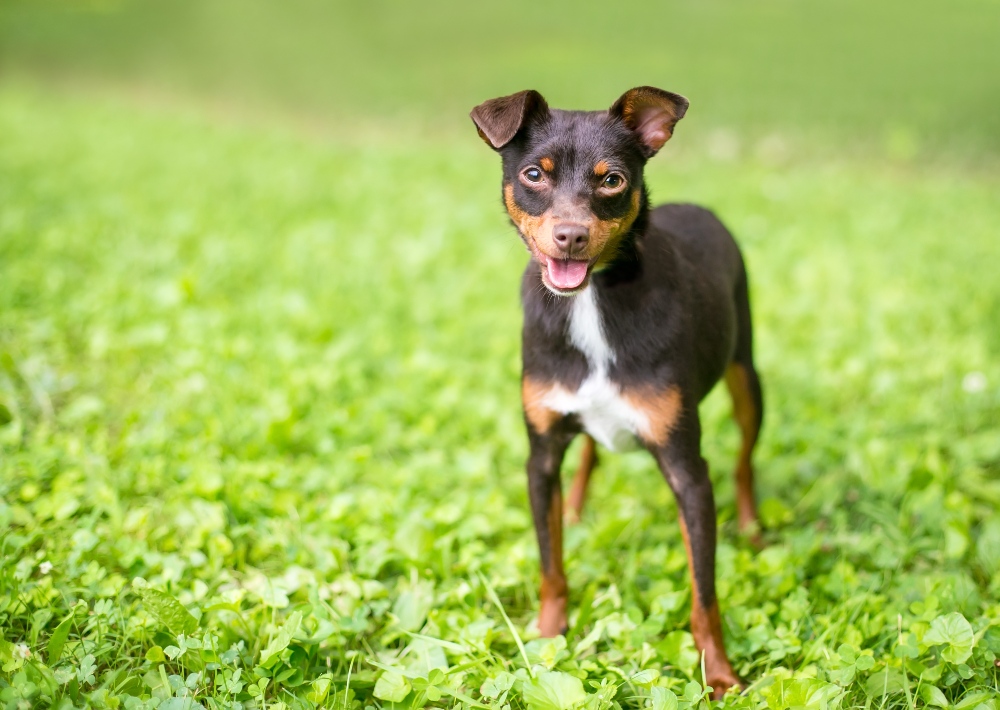Table of Contents
Introduction to Miniature Pinschers
Affectionally known as the “min pin,” miniature pinschers are Toy Group dogs that are fun-loving and have a long life expectancy and a fearless attitude. They are compact with smooth coats and “big dog” personalities that are often hilarious to watch.
There is a common misconception that miniature pinschers are just tiny versions of the Doberman pinscher. Actually, the min pin is a separate breed in and of itself – probably developed from a mix of the German pinscher, dachshund, and Italian greyhound.
If you want a peppy, intelligent, and handsome dog with lots of love to give, a miniature pinscher might be just what your household needs!
Size of Miniature Pinschers
Miniature pinschers are tiny dogs that, according to their breed standard, should weigh just eight to 10 pounds and stand 10 to 12.5 inches tall at the shoulder as adults. Min pins not destined for the show ring can vary a bit from the breed standard.
These dogs usually reach their final adult height by 10 months of age or so; however, their social and emotional development continues to evolve until they are about 15 months old. There are only very small differences in the sizes of male and female min pins; however, males are almost always a bit larger than females.
Here’s how big you can expect your miniature pinscher to get when fully grown.
| Weight Chart | 3 months | 6 months | 9 months | 12 months |
|---|---|---|---|---|
| Male and Female Miniature Pinschers | 3.9 – 4.8 lbs. | 7 – 8.8 lbs. | 8.1 – 10.3 lbs. | 8 – 11 lbs. |
Characteristics of Miniature Pinschers
Miniature pinschers are excellent companion dogs that are high-energy, alert, and confident. People often underestimate the exercise needs of min pins. These pups should get a good amount of exercise every day to stay healthy and strong, but thankfully, this isn’t too difficult due to their small size.
These dogs are also curious pups that love to investigate things. This means that you’ll need to watch your min pin closely and never let him or her outside without a leash to avoid an escape situation. Miniature pinschers can be strong-willed, so this might not be the best breed for a first-time pet parent.
As you get to know a miniature pinscher’s personality, here’s what you can expect based on his or her breed characteristics.
| Breed Characteristic | Level (High, Medium, Low) |
|---|---|
| Affectionate with People | High |
| Good with Kids | Medium |
| Good with Pets | Medium |
| Need for Exercise | Medium |
| Energy Level | High |
| Intelligence Level | High |
| Able to Be Trained | Medium |
| Amount of Barking | High |
| Amount of Shedding | Low |
History of Miniature Pinschers
The exact origin of the miniature pinscher is somewhat unknown, but historians believe that these dogs are a cross of the dachshund and Italian greyhound, with perhaps with a bit of the German pinscher mixed in too. The breed dates back several hundred years and was originally developed in Germany to keep rats away from homes and stables. This is an older breed than the Doberman pinscher, which is a distinct breed even though the two kinds of pups have similar appearances.
German breeders created the Pinscher Klub in 1895, and the dog was first shown at Germany’s Stuttgart Dog Show in 1900. The breed became more well-known outside of Germany in the years that followed and was brought to the U.S. around 1919. The American Kennel Club began recognizing the breed in 1925, and the Miniature Pincher Club of America formed in 1929. Miniature pinchers continue to be a popular breed of dog in Europe and America today.
Miniature Pinscher Standard Information
Since miniature pinschers are purebred dogs, the American Kennel Club uses standards to guide shows and competitions. These standards describe the dog’s specific qualities as well as their general appearance, which is sturdy, compact, smooth-coated, and naturally well-groomed.
Here is an overview of the breed standard information for miniature pinschers:
Head:
- Tapering and narrow head
- Slightly oval, clear, and dark eyes
- High set ears, erect from base to tip
- Flat, forward-tapering skull
- Strong, not delicate, muzzle
- Scissors bite for teeth
Neck, Topline, Body:
- Gracefully curved neck
- Compact, muscular body
- Well-developed forechest
- Strong and short loin
- High-set tail, held erect
Forequarters:
- Clean and sloping forequarters
- Elbows close to body
- Dewclaws removed
- Catlike, small feet
Hindquarters:
- Legs straight and parallel
- Well-muscled thighs
- Well-defined stifles
Coat:
- Short, hard, and smooth coat
- Lustrous coat that uniformly covers body
Color:
- Shades of red, black with rust-red markings, chocolate with rust-red markings
- White on any part of dog should not exceed ½ inch
Gait:
- High-stepping
- Free and easy gait
- Smooth and strong drive from the rear
- Head and tail carried high
Caring for Miniature Pinschers
Miniature pinschers are adaptable dogs that often do very well in small spaces. They get along with dogs and cats if they are socialized, but these aren’t dogs to leave alone all day by themselves. This is because they are social pups that can get into things they’re not supposed to and chew things if they become bored.
Here are some general tips for taking the best care of a miniature pinscher:
Best Living Environments:
- Apartments with limited space are usually fine, although barking can be a problem
- Houses with small, fenced-in backyards
- Not best around very small children who may be too rough – best for kids ages 10 and older
Type of Exercise:
- Playing fetch and games with people
- Light hiking for a mile or two
- Running around the house or yard
- Walks around the neighborhood
Mental Enrichment:
- Food puzzles when left alone
- Give lots of attention
- Flimsy toys may get chewed through and destroyed
Training Strategies:
- Smart but can be independent and stubborn
- Positive training methods only
- Start obedience training classes early
- Can be trained to be a watchdog
Grooming Tips:
- Very easy to groom with just weekly brushing
- Average amount of shedding, but less hair than many large or long-haired dogs
- Don’t bathe too often to avoid dry skin (simply wiping the coat with a warm washcloth works great after outdoor playtime)
- Brush teeth regularly with a toothpaste designed for dogs
- Trim nails regularly or get professionally trimmed
Common Health Problems of Miniature Pinschers
Pet parents should know that min pins typically live for around 12 to 16 years, which is longer than many other (especially larger) dog breeds. However, these tiny pups are still prone to certain health conditions that can have you spending more time at the vet than you’d expect.
To help you pay for rising vet costs and give you peace of mind that you can always take the best care of your min pin, be sure to consider a pet insurance plan from Healthy Paws.
These are some of the most common health issues that arise with miniature pinschers:
- Progressive retinal atrophy and other eye diseases
- Epilepsy
- Legg-Calve-Perthes Disease of the hip joint
- Patellar luxation of the knee
- Hypothyroidism, which can lead to other conditions but is treatable
- Mucopolysaccharidosis (MPS) VI, a genetic disease that all breeding min pins should be screened for
The Orthopedic Foundation for Animals recommends that, at a minimum, miniature pinschers intended for breeding get a patella evaluation to check the health of their knees and that they be screened for at least two other common health problems.
Not all health problems in miniature pinschers are related to genetics. To prevent accidents in the house, it is a smart idea to baby-proof your home so that your min pin can’t accidentally ingest small items, fall off high surfaces, or escape out of window or door screens.
Diet and Nutrition for Miniature Pinschers
Most adult miniature pinschers will thrive when eating a high-quality, nutritionally complete and balanced dog food. Puppies should eat puppy food until they are around 10 months old. If you feed your min pin homemade dog food, make sure you are working from a recipe that is designed by a veterinary nutritionist and that is appropriate for your dog’s age and health status.
Feed the amount of dog food needed to keep your pet slim. You should be able to see your miniature pinscher’s waist and feel (but not see) their ribs without having to press too hard. In general, puppies need more calories per day than do adults, but a dog’s requirements will vary with his or her activity level and other factors. Don’t leave food out all day for a miniature pinscher to graze on. Divide the total amount of food for the day into at least two meals for adults and three to five meals for puppies. Place the food out in a bowl at approximately the same time each day.
Talk to your veterinarian if you have any questions about your Miniature Pinscher’s diet or health.
Where to Adopt or Purchase Miniature Pinschers
If you want to bring a purebred miniature pinscher into your home, the AKC Marketplace is a good place to start because only AKC-registered litters and breeders who follow special rules and regulations are listed here. The Miniature Pinscher Club of America is an official breed group that provides information about the breed, promotes responsible breeding practices, and offers resources for purchasing a purebred min pin.
However, you can also find min pins and mixed breeds with min pin genetics in local animal shelters all around the country. Some people buy purebred min pins and later discover that they aren’t able to handle their behaviors or be home enough to take the best care of the new dog. There are also programs available to help you find a senior miniature pincher in need of a loving home.
Save A Rescue, Pets Established, and Pet Finder are examples of websites that help connect people to miniature pinchers in their area. The Internet Miniature Pinscher Service, Miniature Pinscher Club of America Rescue, and Southern Star MinPin Rescue, Inc. are rescue groups to look into if you want to adopt a min pin.
Related Breeds
People who love the miniature pinscher breed are often curious to learn about related and similar breeds that might suit their need for a canine companion too. Here are some other breeds to consider for your next furry friend:
- German pinscher
- Italian greyhound
- Doberman pinscher
- Toy Manchester terrier
Pet Insurance for Miniature Pinschers
Miniature pinschers benefit from having pet insurance because of their inquisitive nature, spirited energy, and long life span. With Healthy Paws pet insurance, you can take your min pin to any licensed vet you choose and submit a photo of your vet bill online to get reimbursed for the costs of care. Our coverage is provided with no maximum limits on claim payouts and pays for accidents and illnesses that are not pre-existing conditions or otherwise excluded under the policy.
We’re in the business of helping you take the very best care of your min pin, so just tell us a few details about your pup to get an instant, online quote!











